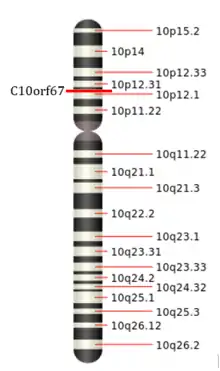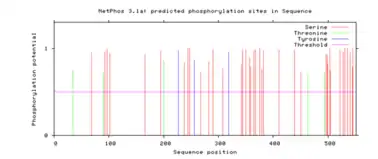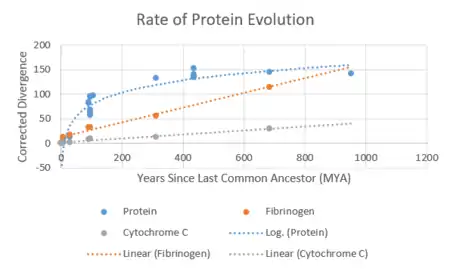C10orf67
Chromosome 10 open reading frame 67 (C10orf67), also known as C10orf115, LINC01552, and BA215C7.4, is an un-characterized human protein-coding gene. Several studies indicate a possible link between genetic polymorphisms of this and several other genes to chronic inflammatory barrier diseases such as Crohn's Disease and sarcoidosis.[3][4][5]
| C10orf67 | |||||||||||||||||||||||||
|---|---|---|---|---|---|---|---|---|---|---|---|---|---|---|---|---|---|---|---|---|---|---|---|---|---|
| Identifiers | |||||||||||||||||||||||||
| Aliases | C10orf67, C10orf115, LINC01552, bA215C7.4, chromosome 10 open reading frame 67 | ||||||||||||||||||||||||
| External IDs | HomoloGene: 82326 GeneCards: C10orf67 | ||||||||||||||||||||||||
| |||||||||||||||||||||||||
| Orthologs | |||||||||||||||||||||||||
| Species | Human | Mouse | |||||||||||||||||||||||
| Entrez |
| ||||||||||||||||||||||||
| Ensembl |
| ||||||||||||||||||||||||
| UniProt |
| ||||||||||||||||||||||||
| RefSeq (mRNA) |
| ||||||||||||||||||||||||
| RefSeq (protein) |
| ||||||||||||||||||||||||
| Location (UCSC) | Chr 10: 23.2 – 23.34 Mb | n/a | |||||||||||||||||||||||
| PubMed search | [2] | n/a | |||||||||||||||||||||||
| Wikidata | |||||||||||||||||||||||||
| |||||||||||||||||||||||||
Gene

The gene spans 142,366 base pairs and is located at the 10p12.2 locus on the minus (-) or sense strand of chromosome 10. It is flanked upstream by the gene ARMC3[6] and downstream by the gene KIAA1217.[7][8] These genes are approximately 150,000 bp and 350,000 bp from C10orf67, respectively.
Transcript
There are 23 alternatively spliced exons, which encode 13 transcript variants. The primary transcript, only 2943 bp, is not well conserved among orthologs, rather, the X2 variant, 3417 bp, has far greater identity with orthologous proteins. This X2 transcript variant contains 15 exons which yield a polypeptide of 551 amino acids.[9][10]
Protein
General properties
| Property | Preprotein | Cleaved protein | Mature protein |
|---|---|---|---|
| Amino Acid length | 551 | 515 | 515 |
| Isoelectric Point | 9.3 | 8.6 | 8.3-8.9* |
| Molecular Weight | 63 kDa | 59 kDa | ~59-61 kDa** |
*depending on post-translational modifications (PTMs)
**From no PTMs - all possible PTMs
The isoelectric point is significantly greater than average for human proteins (6.81).[11]

Structure
Shown to the right is a predicted tertiary structure of the protein. It is marked by long alpha-helices with several coil regions and beta strands localized to the end of the protein opposite the N- and C- terminal ends.
Expression

C10orf67 is moderately expressed (50-75%) in most tissues in the body.[13] However, a study on NCBI GEO discussing the influence of interleukin-13 (IL-13) on gene expression[14] found that protein expression dropped to zero in the presence of IL-13 in airway epithelia.
Subcellular localization
The protein contains a mitochondrial signal peptide localizing it to the mitochondrial matrix.[15] Analysis with subcellular localization software[16][17] confirmed this finding. However, some orthologs were also predicted to localize in the nucleus. Though the high isoelectric point of the Human protein provides further evidence for the mitochondrial localization due to the high pH of the mitochondrial matrix.
Cleavage sites
The protein is initially cleaved to remove the 36 amino acid N-terminal signal peptide after it is localized to the mitochondrion.[18]
Phosphorylation

There are a number of predicted phosphorylation sites, however there is one experimentally-confirmed phosphorylation site at threonine 69.[19] The other phosphorylation sites are summarized in the protein diagram below.
Sumoylation
There are five predicted sumoylation sites within C10orf67. These are summarized by the following table:
| No. | Pos. | Group | Score |
|---|---|---|---|
| 1 | K461 | NSFHV LKNE MFTRH | 0.91 |
| 2 | K401 | MPKKA LKED QAVVE | 0.91 |
| 3 | K224 | EVIKE LKEE LDQYK | 0.91 |
| 4 | K136 | KFEDR LKEE SLS L | 0.91 |
| 5 | K130 | KQLLQ LKFE DRLKE | 0.91 |

Homology and evolution
Evolution
C10orf67 has no known paralogs but has many orthologs within eukaryotes and retains significant identity with species as distantly related as invertebrates. Several select orthologs are listed below with some identifying information.
| Genus and Species | Common Name | Organism Type | Time Since Last
Common Ancestor (million years ago) |
Accession #
(NCBI) |
Sequence Length | % Identity | Isoelectric Point
(pre-protein) |
|---|---|---|---|---|---|---|---|
| Homo Sapiens | Humans | Primate | 0 | XP_016871518 | 551 | 100 | 9.3 |
| Pan troglodytes | Chimpanzee | 6.65 | XP_009456334 | 573 | 95 | 9.27 | |
| Macaca nemestrina | Southern pig-tailed macaque | 29.44 | XP_011736768 | 572 | 88.1 | 9.17 | |
| Bubalus bubalis | Water Buffalo | Mammal | 96 | XP_006080042 | 565 | 56.6 | 6.24 |
| Felis catus | Cat | 96 | XP_019689630 | 560 | 55.1 | 7.68 | |
| Sus scrofa | Wild Boar | 96 | XP_013835714 | 515 | 55 | 6.53 | |
| Panthera pardus | Leopard | 96 | XP_019316071 | 504 | 53.9 | 6.24 | |
| Ovis aries | Sheep | 96 | XP_012043724 | 516 | 53.6 | 6.61 | |
| Mustela putorius furo | Ferret | 96 | XP_012914379 | 566 | 50.8 | 9.34 | |
| Castor canadensis | Beaver | 90 | XP_020038711 | 617 | 44 | 8.92 | |
| Mus musculus | Mouse | 90 | NP_081876 | 560 | 43.6 | 5.89 | |
| Myotis lucifugus | Little Brown Bat | 96 | XP_014316001 | 598 | 38.9 | 6.22 | |
| Myotis brandtii | Brandt's bat | 96 | XP_014394869 | 639 | 38.3 | 6.7 | |
| Elephantulus edwardii | Cape elephant shrew | 105 | XP_006887164 | 493 | 37.9 | 5.62 | |
| Gallus gallus | Chicken | Bird | 312 | XP_003640687 | 430 | 26.3 | 5.44 |
| Astyanax mexicanus | Mexican Tetra | Fish | 435 | XP_007253068 | 475 | 26.1 | 4.76 |
| Lepisosteus oculatus | Spotted Gar | 435 | XP_015208957 | 479 | 25.2 | 6.73 | |
| Danio rerio | Zebrafish | 435 | XP_698346 | 461 | 24.5 | 5.93 | |
| Salmo salar | Atlantic Salmon | 435 | XP_013995887 | 455 | 21.6 | 6.18 | |
| Amphimedon queenslandica | Reniera | Invertebrate | 951.8 | XP_011402872 | 513 | 24.1 | 7.05 |
| Branchiostoma belcheri | Branchiostoma | 684 | XP_019645941 | 563 | 23.5 | 6.24 |
Evolution

The rate of evolution of C10orf67 was compared to that of fibrinogen and cytochrome c, which represent fast and slow rates of evolution, respectively. The bolded species in the table were selected to represent the fibrinogen and cytochrome c orthologs to determine the rate of evolution of the respective proteins.
The rate of evolution of C10orf67 is very curious in that it follows a logarithmic trend rather than a linear trend, like most proteins.
Clinical significance
Sarcoidosis
While the function of C10orf67 is unknown, its interactions with IL-13 further suggest a role of C10orf67 in sarcoidosis as the disease is known to involve various interleukins.
Cancer
While several NCBI GEO profiles examining various factors on gene expression show that C10orf67 is expressed in varying levels in different cancer tissues,[20][21] the mitochondrial localization may yield some insight as to a clinical function. Mitochondria have been shown to have some influence in cell proliferation. Given the high energy demand from cell proliferation, there have been several hypotheses that the mitochondria may play a role in the cell cycle and that C10orf67, being localized to the mitochondria, may have a hand in this as well.
References
- GRCh38: Ensembl release 89: ENSG00000179133 - Ensembl, May 2017
- "Human PubMed Reference:". National Center for Biotechnology Information, U.S. National Library of Medicine.
- Thiébaut R, Esmiol S, Lecine P, Mahfouz B, Hermant A, Nicoletti C, Parnis S, Perroy J, Borg JP, Pascoe L, Hugot JP, Ollendorff V (2016-01-01). "Characterization and Genetic Analyses of New Genes Coding for NOD2 Interacting Proteins". PLOS ONE. 11 (11): e0165420. doi:10.1371/journal.pone.0165420. PMC 5094585. PMID 27812135.
- Cozier YC, Ruiz-Narvaez EA, McKinnon CJ, Berman JS, Rosenberg L, Palmer JR (October 2012). "Fine-mapping in African-American women confirms the importance of the 10p12 locus to sarcoidosis". Genes and Immunity. 13 (7): 573–8. doi:10.1038/gene.2012.42. PMC 3475762. PMID 22972473.
- Franke A, Fischer A, Nothnagel M, Becker C, Grabe N, Till A, Lu T, Müller-Quernheim J, Wittig M, Hermann A, Balschun T, Hofmann S, Niemiec R, Schulz S, Hampe J, Nikolaus S, Nürnberg P, Krawczak M, Schürmann M, Rosenstiel P, Nebel A, Schreiber S (October 2008). "Genome-wide association analysis in sarcoidosis and Crohn's disease unravels a common susceptibility locus on 10p12.2". Gastroenterology. 135 (4): 1207–15. doi:10.1053/j.gastro.2008.07.017. PMID 18723019.
- "ARMC3 armadillo repeat containing 3 [Homo sapiens (human)] - Gene - NCBI". www.ncbi.nlm.nih.gov.
- "KIAA1217 KIAA1217 [Homo sapiens (human)] - Gene - NCBI". www.ncbi.nlm.nih.gov.
- "C10orf67 chromosome 10 open reading frame 67 [Homo sapiens (human)] - Gene - NCBI". www.ncbi.nlm.nih.gov. Retrieved 2017-04-30.
- "Homo sapiens chromosome 10 open reading frame 67 (C10orf67), mRNA". www.ncbi.nlm.nih.gov. Retrieved 2017-02-05.
- Database, GeneCards Human Gene. "C10orf67 Gene - GeneCards | CJ067 Protein | CJ067 Antibody". www.genecards.org. Retrieved 2017-02-06.
- Kozlowski, Lukasz P. "Proteome-pI - Proteome Isoelectric Point Database statistics". isoelectricpointdb.org. Retrieved 2017-04-30.
- Kelley, Lawrence. "PHYRE2 Protein Fold Recognition Server". www.sbg.bio.ic.ac.uk. Retrieved 2017-05-05.
- "GDS4794 / 1553845_x_at". www.ncbi.nlm.nih.gov. Retrieved 2017-04-30.
- "GDS4981 / ILMN_1719577". www.ncbi.nlm.nih.gov. Retrieved 2017-04-30.
- "uncharacterized protein C10orf67, mitochondrial [Homo sapiens] - Protein - NCBI". www.ncbi.nlm.nih.gov. Retrieved 2017-05-05.
- "PSORT II Prediction". psort.hgc.jp. Retrieved 2017-05-05.
- "MitoFates". mitf.cbrc.jp. Retrieved 2017-05-05.
- "WoLF PSORT: Protein Subcellular Localization Prediction". wolfpsort.hgc.jp. Retrieved 2017-04-30.
- "Thr69". www.phosphosite.org. Retrieved 2017-04-30.
- "GDS4080 / 1553844_a_at". www.ncbi.nlm.nih.gov. Retrieved 2017-05-06.
- "GDS1807 / 1553843_at". www.ncbi.nlm.nih.gov. Retrieved 2017-05-06.

